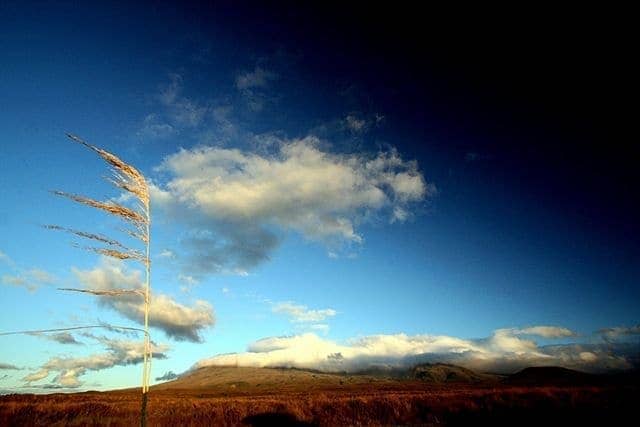The southern alps alone are home to around thirty peaks which rise in excess of 3000 metres – only Mount Ruapehu on the north island comes close – and even he is short by 300 metres, coming in at 2672 metres.
There are, in fact, only three mountains on the north island which cross the 2000 metre line, Mount’s Ruapehu, Ngauruhoe and Taranaki. The first two of these can be found within the Tongariro National Park in the centre of New Zealand’s north island, which is where I have been lucky enough to live for the last four months.
The third of these, Mount Taranaki, lies 180km to the west, on the shores of the Tasman sea, and it is to this mountain that we are travelling in the next few days.
Two of these mountains (Ngauruhoe is geologically just an offshoot of Tongariro) are part of a classic piece of Maori mythology, which explains why Taranaki is so far removed from the main volcanic plateau, brooding as he does at the centre of an otherwise flat plain, surrounded by crashing surf and black sand beaches. The story goes something like this:

Back in the mists of time, there were four male warrior mountains in the area today known as the Tongariro National Park. These were Mount Tongariro, Taranaki, Tauhara and Pūtauaki. Also in the area – and still here today – was the stunningly pretty maiden mountain known as Pihanga.
Naturally, warrior mountains being as they are, a great battle broke out between them to decide who would be the lucky winner of her affection. After tremendous fighting, and no doubt some fire and smoke, Tongariro emerged victorious, and the other mountains fled through the night, with daylight freezing them in their present locations.
Mount Tauhara ended up at the other end of Lake Taupo, where he sits today, presiding over the lake shore town of Taupo, some 60km to the north. Mount Pūtauaki went east and ended up at Kawerau.
Mount Taranaki, being a larger sort of chap, headed for the coast, some 180km to the west. On his way he made a bit of a mess of the landscape, forming the gorges of the fast flowing Whanganui river, as well as the swamps of Te Ngaere.
These days Taranaki sits at the coast, bemoaning his lost love. The legend says that when he is cloud covered, he is weeping for Pihanga, and when he shines through the sunset, he is showing off his glory. Tongariro, on the other hand, lets off the odd bit of smoke and ash, as a reminder to Taranaki not to bother coming back.
It’s not all bad news for Taranaki though. His location is very beautiful, and he is regarded as one of the most perfectly shaped volcano cones in the world due to his symmetry. As a result of this symmetry, and his resemblance to Japan’s Mount Fuji, he acted as the stand-in for the Japanese mountain in the Tom Cruise epic, The Last Samurai. Which is clearly not Lord of the Rings, but still. Take what you can get I say.

Heve Mckenzie says
yolo.
Alexander van den Bosch says
There are many versions to the creation of N.Z but all forms of people will tell the stories as told to them.A book in just the same .But when one hears the times form a long past from a Maori women
of whom lived 120years+ died 1975 back in the days when there was no birth certificates let alone many thing of 2011.So tack care tread old where voices tell us .Ki a Tu Pa To !!!
We don’t have bad thing e.g: Snake’s etc only a native spider.Any way you missed out Pihanga
twin sister and how she too longed for home.
Laurence says
Hi alexander and thanks for your comments. I had not heard the part about
pihangas sister so thanks for sharing that 🙂
Claudia says
A lot of the Maori stories are actually a verbal map for a culture with oral history. Notice how you learn the locations of the mountains relative to each other and other landmarks, and also about the Whanganui river gorges.
Laurence says
In some ways similar to the aboriginal tales also, which describe how
the landscape was formed 🙂
Gavin Downes says
Cant say I have heard that version of the myth, being from turangi we were told that it was Tongariro, Ngauruhoe, Taranaki and Ruapehu, scrapping it out, another version I heard from someone not from tuwharetoa was that they were scrapping over ngauruhoe. Also it is Pihanga not Pihunga
Laurence says
Hey Gavin 🙂 Thanks for the clarification on the spelling, appreciated.
I checked the story facts with this site:
http://www.teara.govt.nz/en/ngati-tuwharetoa/5, but I guess there are
plenty of mountains which could be used! Thanks for stopping by and
commenting!
Awhina Tours says
Beautiful legends. I always thing that the Maori version of how this country was formed is far more interesting than the dry geological facts we often learned at school.
Amanda Williams says
I don’t know how I missed this post! It’s great! I love all the Maori legends in New Zealand… they’re all so interesting. One of my favorites, I think, is the legend of Lake Wakatipu.
Laurence says
Well.. you can’t say that and not give us a link to a post you’ve
written about it!
Amanda Williams says
Haha, I actually haven’t written one! Maybe I’ll have to soon though, now that you mentioned it! In fact, maybe I’ll steal your idea and share a couple of the Maori myths that I like!
Magda says
I love those photos! New Zealand is a splendid destination!
Laurence says
It sure is Magda, and thanks!